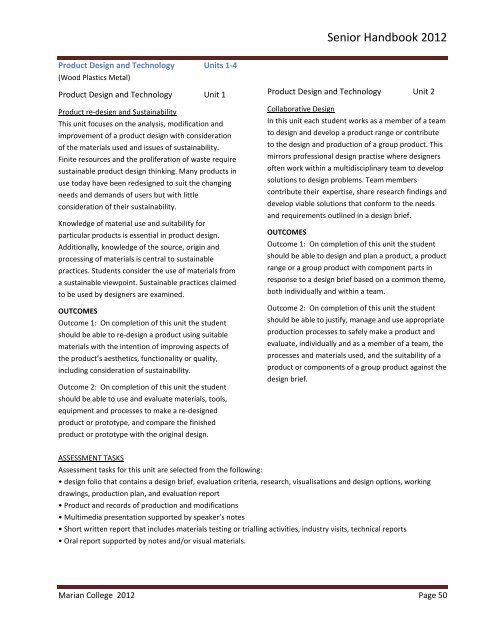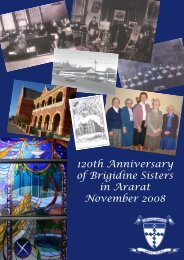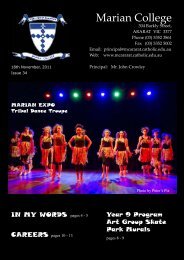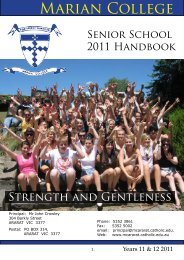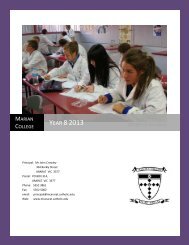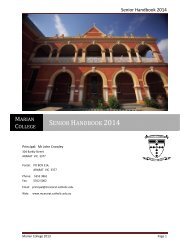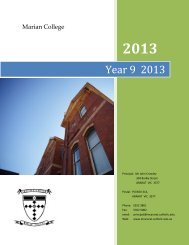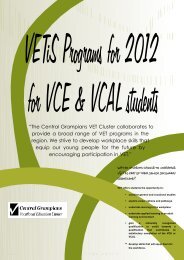Senior Handbook 2012 - Marian College
Senior Handbook 2012 - Marian College
Senior Handbook 2012 - Marian College
Create successful ePaper yourself
Turn your PDF publications into a flip-book with our unique Google optimized e-Paper software.
<strong>Senior</strong> <strong>Handbook</strong> <strong>2012</strong><br />
Product Design and Technology Units 1-4<br />
(Wood Plastics Metal)<br />
Product Design and Technology Unit 1<br />
Product re-design and Sustainability<br />
This unit focuses on the analysis, modification and<br />
improvement of a product design with consideration<br />
of the materials used and issues of sustainability.<br />
Finite resources and the proliferation of waste require<br />
sustainable product design thinking. Many products in<br />
use today have been redesigned to suit the changing<br />
needs and demands of users but with little<br />
consideration of their sustainability.<br />
Knowledge of material use and suitability for<br />
particular products is essential in product design.<br />
Additionally, knowledge of the source, origin and<br />
processing of materials is central to sustainable<br />
practices. Students consider the use of materials from<br />
a sustainable viewpoint. Sustainable practices claimed<br />
to be used by designers are examined.<br />
OUTCOMES<br />
Outcome 1: On completion of this unit the student<br />
should be able to re-design a product using suitable<br />
materials with the intention of improving aspects of<br />
the product’s aesthetics, functionality or quality,<br />
including consideration of sustainability.<br />
Outcome 2: On completion of this unit the student<br />
should be able to use and evaluate materials, tools,<br />
equipment and processes to make a re-designed<br />
product or prototype, and compare the finished<br />
product or prototype with the original design.<br />
Product Design and Technology Unit 2<br />
Collaborative Design<br />
In this unit each student works as a member of a team<br />
to design and develop a product range or contribute<br />
to the design and production of a group product. This<br />
mirrors professional design practise where designers<br />
often work within a multidisciplinary team to develop<br />
solutions to design problems. Team members<br />
contribute their expertise, share research findings and<br />
develop viable solutions that conform to the needs<br />
and requirements outlined in a design brief.<br />
OUTCOMES<br />
Outcome 1: On completion of this unit the student<br />
should be able to design and plan a product, a product<br />
range or a group product with component parts in<br />
response to a design brief based on a common theme,<br />
both individually and within a team.<br />
Outcome 2: On completion of this unit the student<br />
should be able to justify, manage and use appropriate<br />
production processes to safely make a product and<br />
evaluate, individually and as a member of a team, the<br />
processes and materials used, and the suitability of a<br />
product or components of a group product against the<br />
design brief.<br />
ASSESSMENT TASKS<br />
Assessment tasks for this unit are selected from the following:<br />
• design folio that contains a design brief, evaluation criteria, research, visualisations and design options, working<br />
drawings, production plan, and evaluation report<br />
• Product and records of production and modifications<br />
• Multimedia presentation supported by speaker’s notes<br />
• Short written report that includes materials testing or trialling activities, industry visits, technical reports<br />
• Oral report supported by notes and/or visual materials.<br />
<strong>Marian</strong> <strong>College</strong> <strong>2012</strong> Page 50


